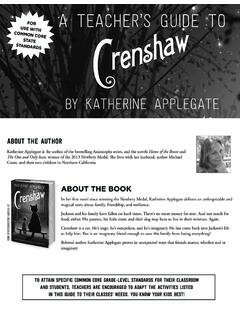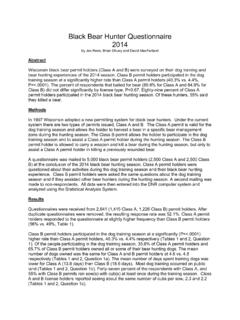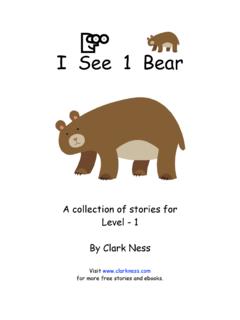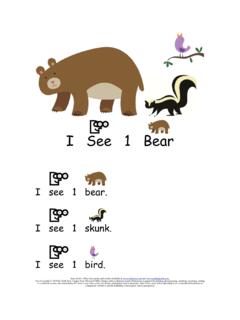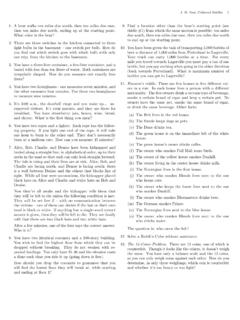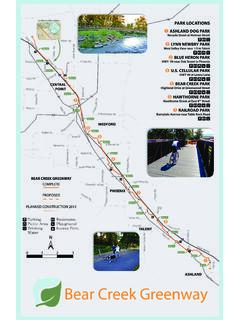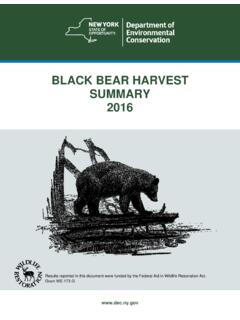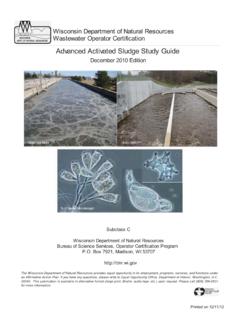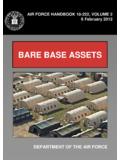Transcription of Teacher Tips Brown Bear, Brown Bear, What Do You See?
1 Brown bear , Brown bear , What Do You See? by Bill Martin Jr, illustrated by Eric Carle This touchstone picture book has earned a spot on bookshelves and in hearts all over the world. Starting with a Brown bear , the animals in the book take turns naming who is looking at them. The rhythmic, repetitive text pairs with the bright, bold collages to create a story that readers want to return to again and again. READ & EXPLORE Start by opening the book so children can see the front and back covers. Do they think the pictures show the same bear or two different bears?
2 Why? When you reach the blue horse, ask the children if they ve ever seen a blue horse. Why do they think Eric Carle made the horse blue? Ask the children to look at the endpapers. They may notice that the colored stripes are in the same order as the colors of the animals that appear in the & SHARE Brown bear , Brown bear , What Do You See? features a blue horse and a purple cat! Ask the children to close their eyes and imagine an animal in a different color. Take time to share what everyone imagined and have them create drawings of the animals.
3 Chant the words with the children s names instead of the animals names. Say Child name, child name, What do you see? and then have that child continue with another child s name, I see _____ looking at me! Using construction paper, craft sticks, and glue, have the children make masks of their favorite animal from Brown bear , Brown bear , What Do You See? Read the book again, having children stand with their masks covering their faces when their animal is TipsThe book explorations and art projects presented here are inspired by open-ended, educational approaches we use every day at The Carle.
4 By encouraging involvement with words, pictures, and art materials, children build their language skills, learn to find meaning in what they see, and practice basic reading and writing all fundamental skills for their future success. Explore EndpapersEndpapers are the pages at the very beginning and end of a book. Eric Carle s endpapers often provide clues to the story RESOURCEBook cover image: Brown bear , Brown bear , What Do You See? by Bill Martin Jr. Illustrated by Eric Carle. Illustration Copyright 1967 by Eric Carle.
5 All rights reserved. Used with image: The Very Hungry Caterpil-lar by Eric Carle. Copyright 1969 & 1987 by Eric Carle. All rights reserved. Used with permission from the Eric Carle Studio. Mice image by Leo Lionni. Copyright 1989 by the estate of Leo Li-onni. Used by permission. Wild Things image by Maurice Sendak. Copyright 1963 by Maurice Sendak, reuse of image in The Eric Carle Museum logo Copyright 2014 by Maurice Sendak Estate, used by permission of The Wylie Agency LLC. Materials Strips of white paper (about 6 x 18 inches) Colored paper scraps (sort by color into small baskets or trays) Scissors Glue sticksBefore you begin the project, look for scraps of paper in all different colors.
6 You can use collage paper, painted paper, tissue paper, and more. For inspiration, see the papers shown in the artwork on this page. 1 Hand out Paper Scraps Set out baskets or trays of colored paper on the work area. Each basket should contain collage papers from one color family. Let each child pick one color basket for the project. 2 Design a Picture Give each child a piece of white paper and scissors. Have them arrange their colored papers on the page, cutting or tearing the papers as they wish. They can design pictures of colorful shapes or make animals or Glue the Shapes Hand out glue sticks so the children can glue down their shapes onto the background the children to arrange their collages together into bands of color like the endpapers of the book!
7 Teacher RESOURCEMy Favorite Color Collage The animals in Brown bear , Brown bear , What Do You See? aren t made with just one type of Brown , red, or yellow color. Eric Carle used a few colors within each color family to make the animals. In this collage activity, children will use their imagination and paper scraps from a single color family to make their own colorful 1 Play with Clay Invite the children to play with their clay ball and try changing the shape using the diagram below. They can roll the clay into a skinny coil with the palms of their hands, flatten the clay into a pancake with their fists, rip the clay and pinch the pieces together with their fingertips, or poke or scratch marks in the clay with their Sculpt a Clay Animal Provide each child with a cardboard square to work on.
8 Now invite the children to shape their clay into an animal head and body. Show them photographs of live animals for Add Details Distribute plastic forks to the children and encour-age them to scratch texture in the clay, just like the lively marks Eric Carle painted in the animal illustrations. Have them add finishing details with twigs, pebbles, rice, or pasta for the animal s teeth, fur, tail, or horns. Teacher RESOURCEA nimal Clay Sculptures The animals in Brown bear , Brown bear , What Do You See? have a variety of features that make them unique beaks, claws, tails, fur, fins, and feathers.
9 Teach children a few basic techniques for sculpting with clay, then let them create their own clay into a skinny coilFlatten into a pancakeRip, then pinch the pieces back togetherCreative Ways to Play with ClayMaterials Natural air-dry clay, rolled into balls Cardboard squares (about 6 x 6 inches) Plastic forks Twigs, pebbles, rice, or pasta pieces Water spray bottle (optional) Liquid water colors or tempera paints in the colors from the endpapers of the book (optional) Paint brushesOptional Allow clay sculptures to dry overnight.
10 Once dry, provide children with paint brushes and liquid watercolors or tempera paint. They can paint their sculptures in one of the bright colors from Brown bear , Brown bear , What Do You See? Make marks with fingernails Materials Finger paint paper or heavyweight drawing paper Finger paint Paint brushes Textured drawing tools (twigs, popsicle sticks, forks, or chopsticks) Tablecloth or newspaper to protect work area SmockPreparing for Collage Once all the papers are dry, have the children cut and tear their paintings into pieces for collages.




